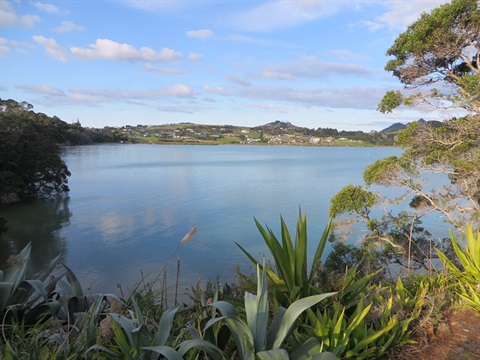Parua Bay Wastewater Scheme
- Project typeWastewater system improvements

We are working to improve the Whangārei Heads and Parua Bay wastewater systems following overflows from the wastewater storage tank at Parua Bay.
Parua Bay pilot study
Wastewater systems are designed to take the wastewater that comes from showers, baths, washing machines, toilets and other household or business sources from the property to a wastewater treatment plant, where it is treated before being disposed of.
When stormwater enters the wastewater system, it can lead to overflows, which is what has been happening at the Parua Bay storage tank.
We have carried out a pilot study to determine where stormwater is entering the wastewater network in Parua Bay, focusing on the area immediately upstream of the storage tank where the majority of connected Parua Bay properties are located.
The study was completed in May 2025, revealing issues within the public network as well as on some private properties.
Smoke testing showed remedial work was required at various manholes on public and private land, including sealing and repairing lids, particularly those located in low-lying areas that are susceptible to flooding. Remediation of these issues will be carried out by our stormwater and wastewater maintenance contractor.
We also engaged with the owners of properties within the pilot study area through surveys and site visits, to explore whether stormwater could be entering gully traps from downpipes, which ultimately feed into the wastewater network.
While most gully traps on private property are in good condition, there are some that are damaged, incorrectly sealed or set too low, making them susceptible to stormwater inflow.
Others are located in areas that are prone to flooding and could be overtopped in rainfall events, and some properties also have stormwater being directed into gully traps via downpipes. We are following up with these property owners to ensure the issues are corrected.
Further investigations are now planned near Taurikura after flow meters detected significantly increased flow coming from this catchment during recent heavy rainfall.
Find out more about smoke testing:
Smoke testing in our wastewater network
Keeping things clean
We have been keeping the area as clean and spill-free as possible during these investigations.
This has included transporting waste from the wastewater storage tank at Parua Bay to the wastewater treatment plant on Kioreroa Road, while we investigate the causes of the overflows and determine the best solutions.
Wastewater
The wastewater system is designed to take the wastewater that comes from showers or baths, washing machines, toilets and other household or business sources, keeping it separate from stormwater.
In Parua Bay, the wastewater system pipes the wastewater to the storage tank, and it is then pumped through to the main wastewater treatment plant in Whangārei.
Stormwater
The stormwater system is designed to gather the rainwater that flows off the land and rises up through the ground, keep it separate from the wastewater system, and direct it into streams, ponds or the sea.
About Parua Bay and Whangarei Heads’ wastewater network
Wastewater drains into the pump station / storage tank from surrounding household connections. When it reaches the right level, a pump sends the wastewater to the next pump station along the line.
It does not empty the tank fully. It sends a manageable amount of wastewater to the next pump station to deal with.
When more wastewater flows into the storage tank, it is added to the amount already in storage and the level rises again, starting the pump again.
The wastewater system along Whangārei Heads depends on every pump along the line working properly, and pumping out at the right time to a storage tank that is empty enough to take the new load.
This cycle works well when wastewater is coming into and being pumped out of the system steadily, but not when there are big fluctuations and very large quantities of wastewater mixed with stormwater coming into the tank very suddenly. When that happens, the tank can be overloaded and there can be an overflow.
Our aim is to direct as much stormwater into the stormwater system as possible and to keep it away from the wastewater system.
Inflow and Infiltration
Inflow is when stormwater flows into the wastewater system from above ground from:
- places where downpipes are draining into gully traps
- gully traps that are underneath leaking spouting / guttering
- damaged gully traps or gully traps that are set low that enable stormwater to drain into them
- non-compliant connections, stormwater connections to the wastewater pipelines
- places where stormwater forms ponds that are higher than the gully trap, letting water flow in.
Infiltration is when water builds up in the ground. As the level rises the pressure on pipes under the ground increases and water can escape into pipes, including wastewater pipes, through holes or cracks or poor connections.
Mapping data from the study
Data from the study has been entered into a digital GIS (Geographic Information System) model, providing rich information about the wastewater system in the area and enabling informed solutions.
Preventing overflows during investigations
Keeping the tanks empty
While investigations continue, we are emptying out the storage tank(s) by sucker truck from time to time to ensure levels don’t get too high and lead to an overflow.
Sucker trucks are removing wastewater from the wastewater storage tank at Parua Bay and taking it to the wastewater treatment plant on Kioreroa Road.
The smell
Opening the cover at the pump station when we began emptying it caused an odour problem, so we have modified the lids and will not need to fully open them as often in future.
Long term planning
When we have completed our investigations and undertaken immediate repairs and improvements, we will have a clearer idea of what needs to be done to meet the needs of the community now and into the future. Planning, design and construction work will begin at that point.